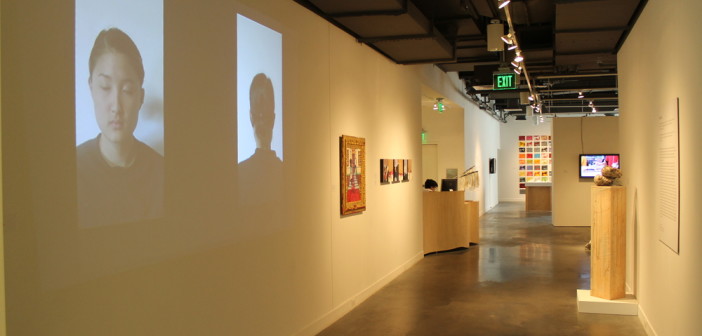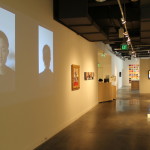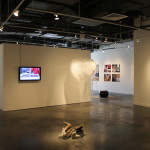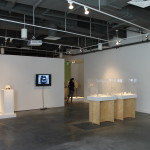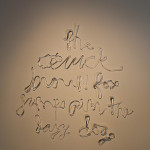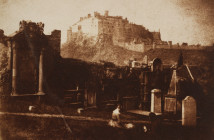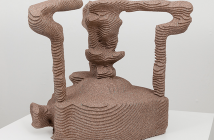The Gelman Gallery at the RISD museum turned into a personal exhibit space secret for me a while ago. Despite being located on the second floor of the museum, it is very easy to just get on the escalator and bypass it completely. Gelman is reserved for RISD students, both BFA and MFA, to come together, curate, collaborate, and present their vision to the community, regardless of how large the number. The most recent show in the space, "Body: Talk," curated by Namwoo Bae, MFA 13 Digital+Media and Ahrong Kim, MFA 13 Ceramics, takes a very broad topic and tries to show an audience numerous interpretations. Even though there are definitely some highlights in the room, the show ultimately sent me in so many different directions that individual work frequently overshadowed the show’s purpose.
A work that immediately catches attention in those first steps into the gallery is by Blake Hiltunen, a first year MFA sculpture candidate. Perched carefully on top of a wooden pedestal sit two heads. Instead of a predictable face-to-face position, "Lovers" are ear to ear. Even though the work was interpreted for the show as delving into understanding atrophy, time, and erosion on the human body, when I view the work, it seemed to be less about physicality and more about the atrophy of emotion and intimacy. Either way Hiltunen gives his audience plenty to unravel. The work also plays with the magic of material by presenting work that encapsulates cement being stripped of its strength only to reveal the frailty of the heads’ embrace or disconnect. Hiltunen gives this show one of only a few works that present the human body in a context that is not trapped by an ideological or art historical "ism."
Another interesting work in the show is an artist trio’s interpretation of a glass alphabet in sentence form. Individually, the cursive handwriting on the wall is aesthetically soothing and inviting to spend time trying to figure out what the words actually say. Within the context of the show, it’s a bit of a stretch. Pulling from gestural action paintings, Alice Taranto, Elie Andersen, and Caroline Bagley, pitch the work to the audience in a way that asks us to envision the hands making the gestures creating the letters, but ultimately even though I could see what they wanted us to see, it wasn’t a natural journey to arrive there.
Further into the gallery, there are ceramic objects that looked like they could be covered in KY and images that were from a French pornographic magazine, but looked like one of Rhianna’s latest instagram sessions. I pressed my hand against David Kim’s "Hot Seat," a bench shaped like a derriere that when warmed up by body heat activated the pigment on the bench to a lighter color. Anna Huemmer’s work caught my attention. She attached blond hair tracks to windshield wiper blades complete with a green air freshener. As the wipers moved back and forth and the hair swings, I caught myself starting to think about Aileen Wuornos. But again, I was not thinking about the work in terms of the curator’s statement, but more of the horrors of a life spent hitchhiking and living off of tricks hoping to not end up dead in a truck stop bathroom stall.
One last work that pulled me in is another example of a work that presents the human body and captures a brief moment in time understandable to everyone. S. Louise Neal contributes bronze moldings of the front and back of her legs. Their positioning on the floor make the legs look like they are spooning and the texture of the gold communicates goose bumps. Neal, like Hiltunen, captures something in the essence of the human body that requires no persuasive argument in why it was included in the show because the work does that for itself.
I don’t think it’s easy to be a curator. It requires not only having an eye for talent, but also being able to edit and weave a story together from many different voices in a cohesive way. It is definitely not as easy as hanging art around a room and there is a reason why curatorial studies have become a master’s program track, even though it is debatable if the skills required to be a truly successful curator can even be taught. The reason why I enjoy the Gelman space so much is because it allows an outside audience to glimpse into what is happening in the minds and studios of the artists at RISD. Bae and Kim took an opportunity to gather work from their peers to try and express something they believed was worth exploring. I don’t think either one of them will ultimately end up being the master curatorial vision behind a biennale or something of equal standing, but the exercise of assembling a show hopefully brought into focus some of the challenges faced when putting together a solid exhibition. Undoubtedly there is a temptation to include as much as possible when there is so much talent to be unearthed because there is a lot of that in this show. This show’s final day happens to fall on the first day of the much anticipated RISD museum, "Artist/Rebel/Dandy: Men of Fashion" exhibition. I would strongly urge a trip to the second floor before the show decomposes.
- Image Courtesy of RISD Exhibitions Flickr Page
- Image Courtesy of RISD Exhibitions Flickr Page
- Image Courtesy of RISD Exhibitions Flickr Page
- Image Courtesy of RISD Exhibitions Flickr Page
Body: Talk is on view until April 28 at the Gelman Gallery - Museum of Art-Rhode Island School of Design.

